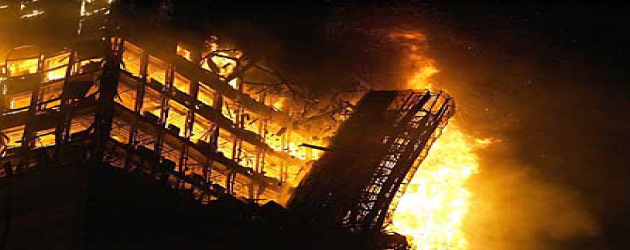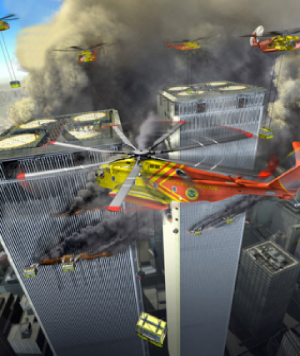By Dan Goodwin
President / Skyscraper Defense, Inc.
Vincent Dunn, a former F.D.N.Y. Deputy Chief, reported in his newsletter nearly a decade ago, “There is a deadly trend in high-rise fires.” Anyone who has been following the news knows the number of skyscrapers catching fire has been rising at an alarming rate. According to the National Fire Protection Association, during the seventeen year period ending in 2002, 1600 civilians died and over 20,000 were injured in the approximate 385,000 high-rise building fires in the United States, excluding the MGM Grand Hotel and the Las Vegas Hilton fires in the early 80’s, and the World Trade Center on September 11, 2001.
BRIEF HISTORY
November 21st, 1980 – The MGM Grand Hotel fire in Las Vegas resulted in the death of 84 people and 600 injuries. Hundreds of occupants were seen clinging to their balconies pleading for help. Some tragically attempted to escape by tying bed sheets together. If it wasn’t for the heroic efforts of the military helicopters retrieving occupants off the upper most balconies and roof of the 26-story hotel, there is little doubt the casualties would have been much higher.
December 31st 1980 – The Dupont Plaza Hotel fire in San Juan, Puerto Rico, resulted in the death of 86 people and 140 injuries. Many were trapped in the upper floors of the 17-story hotel. Three died in the elevators. The majority of the fatalities occurred when fleeing guests were trapped inside the casino area.
February 10th 1981 – The Las Vegas Hilton Hotel fire resulted in the death of 8 people and 350 injuries. Smoke and flames spread vertically on the exterior walls until it reached the top floor of the 30-story hotel. It was ruled, the presence of highly combustible carpet on the walls and ceilings contributed to the rapid spread of the fire.
May 4th 1988 – The 62-story First Interstate Bank building in downtown Los Angeles proved to be one of the most challenging and difficult high-rise fires in the city’s history. The fire, which continued unabated for 24 hours, destroyed four floors, claimed one life, and injured 35 occupants and 14 firefighters.
June 30th 1989 – The 10-story Peachtree Building fire in Atlanta, Georgia, resulted in the death of five building occupants while injuring 20, including six firefighters.
February 23rd, 1991 – A twelve-alarm fire gutted eight floors of the 38-story One Meridian Plaza building in Philadelphia, Pennsylvania. The fire raged for 18 hours. Three firefighters were trapped on a fully engulfed floor, and efforts to rescue them failed. Fire officials called off the attack and allowed the fire to ‘free burn’, concentrating their efforts instead on containment.
February 26th, 1993 – A 1,500-pound bomb created a 4-story deep crater in the sub-ground level of the North Tower of the World Trade Center in New York City, causing a fire that spewed smoke into the upper levels of the 110-story building. Six people were killed and 1042 people were injured, mostly from smoke inhalation.
Nov. 21st, 1996 – The worst fire in Hong Kong’s history occurred in an office building on Nathan Street. People were seen leaping from the windows to escape the flames. The fire was so intense it turned the entire skyscraper into a towering inferno, killing 40 people and injuring 81.
February 23rd, 1997 – The Bangkok President Tower, a 36-floor complex on Ploenchit Road, caught fire, destroying the seventh to tenth floor, leaving three dead.
December 8th, 1997 – At least 14 people died in a fire that engulfed the top floors of a new tower block in Indonesia’s central bank complex in Jakarta.
September 11th 2001 – Over two thousand people lost their lives in the World Trade Center complex in New York City following the crashing of two hijacked commercial jets into the Twin Towers. Following brief fires, both steel-framed towers collapsed. Hours later, the 47-story World Trade Center # 7, a steel-framed building built in the mid-1980’s and designated as ‘fireproof’, collapsed from fire even though it was not hit by the hijacked planes.
October 18th, 2004 – Parque Central, a 56-story office tower in Caracas, Venezuela, the same building where in 1982 I conducted a high-rise firefighting seminar and then scaled, was engulfed in flames. For more than 17 hours, the fire raged. Two floors in the skyscraper, and several staircases, collapsed as the fire spread through 26 of the skyscraper’s 56 floors, forcing the evacuation of neighboring buildings. The temperatures were so intense the firefighters ceased operations, fearing a collapse similar to what occurred on September 11, 2001, at the World Trade Center. Though the fire was much larger and burned many hours longer than the World Trade Center fires, the building remained standing.
February 14th, 2005 – The Windsor Building in Madrid, Spain, burned like a roman candle for two days. At one point, the entire 32-story skyscraper was engulfed in flames. Several of the top floors collapsed onto the lower ones and it was feared the entire structure would collapse. However, like the Parque Central fire, the skyscraper remained standing.
February 9th 2009 – Fire in the newly constructed 44-story Mandarin Oriental hotel in downtown Beijing turned the building into a towering inferno. However, like Madrid’s Windsor Building, the skyscraper remained standing. One firefighter died, six others were injured.
COMMON DENOMINATORS
The first and most obvious fact is that skyscrapers have the potential of becoming towering infernos. In the book, High-Rise Security and Fire Line Safety, Geoff Craighead illustrates how modern high-rise buildings are less fire resistant than the previous generation, such as the Empire State Building, because of their lightweight steel construction and their potential for larger fires due to open floor designs.
The second and most alarming fact is that they all occurred beyond the reach of fire department ladders. Architects and developers are constructing skyscrapers even taller, acting as if 9/11 never happened. The 2,717 foot tall Burj Khalifa in Dubai, the 2,000 foot Chicago Spire (construction temporarily halted), and the 1,776 foot One World Trade Center (currently under construction), are three cases in point. Knowing what we know about the extraordinary challenges firefighters face in towering skyscrapers, there is a growing consensus that the methods used to fight fires in the upper floors need to be radically modified.
TIME FACTOR
As Einstein said… “The act of insanity is doing the same thing over and over and expecting different results.” Sending firefighters charging up the stairs of a tall building to wage war on the 70th or 80th floor is the epitome of such an act, especially when it’s a known fact that firefighters, burdened by the weight of extra hoses and oxygen tanks, take an average of two-to-three minutes to ascend a floor. People trapped above the fire do not have the luxury of waiting several hours for the fire department to arrive, and as we learned on 9/11, neither does the structural integrity of the building. There is, however, another option…
ATTACK FROM ABOVE
Instead of attacking the fire from the street level, which requires firefighters to either storm up the stairs or risk being trapped inside of an elevator (a leading cause of firefighter fatalities), attacking the fire from the roof is an alternative that should be explored.
Robotic Firefighting Pods – Representing the first line of defense, robotic firefighting pods can be activated within minutes then remotely controlled from a hovering helicopter, a neighboring building, or a command center within the building. Using technology that has been available since the time man first walked on the moon, these robotic machines can be lowered to the source of the fire without endangering firefighter’s lives. Then, through the use of HD and infrared cameras beaming images to controllers, a steady stream of fire retardant foam or water can be directed at the flames.
Manned Firefighting Pods – Designed to ‘follow-up’ the robotics, manned pods can be lowered from the roof or hovering helicopters to the hot zones. Once there, firefighters are able to chase the fire into the belly of the building with hoses feeding from the pod they exited. Think of it as a…
TWO-PRONG ATTACK
The first line of defense, robotic firefighting pods, knock the fire down. The second line of defense, manned firefighting pods, enter the scene with the intention of extinguishing the fire’s remnants. These revolutionary firefighting machines not only have the ability to combat fires in the upper floors of high-rise buildings, but also to save countless lives, including the firemen themselves. Imagine what might have happened had the World Trade Center been equipped with similar devices. The Twin Towers could still be standing!




